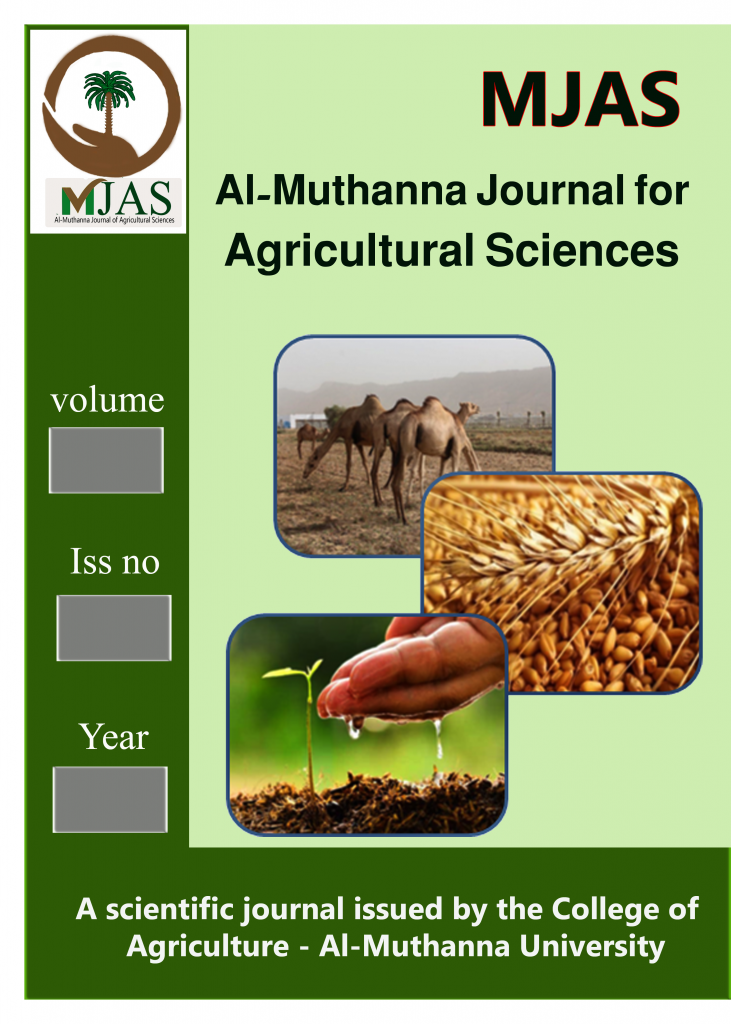Abstract
A field experiment was conducted during the agricultural season 2023-2024 inside
the greenhouse at the Second Agricultural Research Station of the College of Agriculture/AlMuthanna University in the Al-Bandar region. The aim of this study was to evaluate the
response of eggplant (variety Barcelona hybrid) to fractionate of potassium fertilizer and
humic acid on the phenotypic and nutritional qualities. Potassium was added according to
the (N:120 P2O5:160 K:120) fertilizer recommendation and the fractionation required was as
P1: Without fertilization, P2: Full recommendation for potassium in one does, P3: Full
recommendation for potassium in two doses, P4: half recommendation for potassium and in
one does, P5: half of the recommendation for fertilizer and in two doses. Humic acid was
added by spraying on the plant and soil in three doses and the concentrations were as (0, 5,
10 ml liter-1
of water) and symbolized by the symbols (H1, H2, and H3) after three weeks for
planting and sprayed on plants in the experimental unit. A factorial experiment was
conducted using Random Complete Block Design (RCBD) with three replications and the
indicators of study were averaged and compared using the Least Significant Difference (LSD)
test at a probability level of 0.05. The results showed that a significant superiority of the full
recommendation treatment of potassium in two doses and the treatment of spraying with
humic at a concentration of 10 ml liter-1
separately in all the studied traits, and the plants of
2
MJAS
the interaction treatment (H3P3) in the characteristic of plant height, chlorophyll content
(SPAD readings), Normalized Difference Vegetation Index (NDVI), and content of elements N,
P and K in the plant, where it reached to 102.330 cm, 74.000, 0.901, 5.500%, 0.450%, and
3.780%, respectively.
the greenhouse at the Second Agricultural Research Station of the College of Agriculture/AlMuthanna University in the Al-Bandar region. The aim of this study was to evaluate the
response of eggplant (variety Barcelona hybrid) to fractionate of potassium fertilizer and
humic acid on the phenotypic and nutritional qualities. Potassium was added according to
the (N:120 P2O5:160 K:120) fertilizer recommendation and the fractionation required was as
P1: Without fertilization, P2: Full recommendation for potassium in one does, P3: Full
recommendation for potassium in two doses, P4: half recommendation for potassium and in
one does, P5: half of the recommendation for fertilizer and in two doses. Humic acid was
added by spraying on the plant and soil in three doses and the concentrations were as (0, 5,
10 ml liter-1
of water) and symbolized by the symbols (H1, H2, and H3) after three weeks for
planting and sprayed on plants in the experimental unit. A factorial experiment was
conducted using Random Complete Block Design (RCBD) with three replications and the
indicators of study were averaged and compared using the Least Significant Difference (LSD)
test at a probability level of 0.05. The results showed that a significant superiority of the full
recommendation treatment of potassium in two doses and the treatment of spraying with
humic at a concentration of 10 ml liter-1
separately in all the studied traits, and the plants of
2
MJAS
the interaction treatment (H3P3) in the characteristic of plant height, chlorophyll content
(SPAD readings), Normalized Difference Vegetation Index (NDVI), and content of elements N,
P and K in the plant, where it reached to 102.330 cm, 74.000, 0.901, 5.500%, 0.450%, and
3.780%, respectively.
Keywords
chlorophyll.
Humic Acid
Potassium Fertilizer
spraying
Vegetative growth
